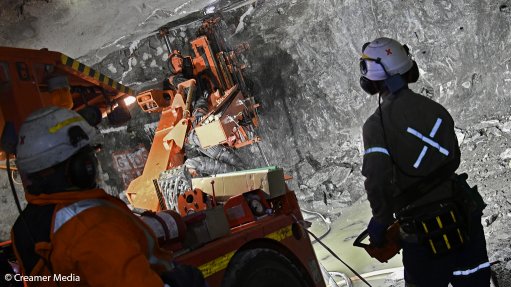
Miners at the Booysendal South mine work on constructing a new decline shaft
Photo by: Creamer Media's Donna Slater
Mining and production expansion plans at platinum group metals miner Northam Platinum’s Booysendal mine are progressing on schedule, with the mine’s South mine (BCU and BCM mining modules) under construction and north aerial conveyor systems nearing completion.
The currently-in-steady-state-production Booysendal North mine has a life-of-mine of 25 years, with Northam stating that the 105.1-million-ounce orebody lends itself to brownfield expansion opportunities, which are currently being established on the property.
These include a deepening project at the existing Upper Group 2 North mine, the Booysendal Merensky North mine and the new Booysendal South mines, which is under construction.
Together, all the current and future mining modules at Booysendal – the North mine and its deepening, the north concentrator plant, the Booysendal Central mine, the Booysendal South mines (1- 4) and the south concentrator plant – will give Northam 500 000 t a month from the Booysendal complex.
The Booysendal complex is situated primarily in Mpumalanga, but with some sections in Limpopo; and is a shallow, mechanised, room and pillar mine on the eastern limb of the Bushveld Complex.
However, the vast volume of ore coming from the current three mining modules, which are situated at a lower elevation in a valley means Northam has to process and mill ore at two plants, one being in the valley – the Booysendal North concentrator – and the other on top of a steep hill – the Booysendal South concentrator.
This creates an issue of ore handling and means Northam had to find an alternative to trucking or conveyor belt handling of ore between the mine and the upper processing plant.
Northam considered using an aerial bucket-type system, similar to a system it says is in operation in Barberton, Mpumalanga, but deemed this system too inefficient for the volume of ore it would need to handle.
ROPECON
This led the miner to consider the RopeCon system, developed in Austria by Doppelmayr and which uses towers and conveyor belt suspended by wire rope and which is able to traverse the hill at a steep gradient.
Booysendal engineering manager Zacharia Tsotetsi says the RopeCon system can deliver about 1 200 t an hour – nearly double the speed of a conventional conveyor belt – which he says will fit into the profile of the central shaft, which is designed to deliver about 220 000 t a month of ore.
Two interlinking RopeCon systems are used at Booysendal, with the South RopeCon already being established, while the North RopeCon – to feed ore from the North mine into the south concentrator plant – under construction.
The south concentrator plant has a 300 000 t a month capacity, some of which is not currently being used.
Tsotetsi tells Mining Weekly the South RopeCon system is currently the longest and biggest operating in the world. It is 4.8 km long and has a motor capacity of 3.5 MW.
He adds that the inclination is also the most severe in the world at 30o as a result of the mountainous topography at Booysendal, with the second most major incline being used on a RopeCon system in Jamaica, at 28o.
To date, Booysendal has moved over 2.6-million tonnes on its South RopeCon, and is currently installing a North RopeCon that will link to the South RopeCon, to increase ore to the south concentrator as the north concentrator is at full capacity.
This is critical as the Booysendal South mines 1 and 2 (accessed through a single decline shaft), is ramping up to 220 000 t a month – its steady-state production volume, which is expected to be achieved in the second half of 2024.
ENVIRONMENT, SOCIAL AND GOVERNANCE
Among the environment, social and governance achievements at the Booysendal mine, Northam reports that the mine has a 91.8% local employment rate, meaning the vast majority of mineworkers come from towns and villages nearest to the mine.
This means Booysendal is able to transport its workers from their homes, to the mine, and back to their homes after their shift, with no hostel-type accommodation needed and workers being near their families.
The mine also changed its initial six-day rotational working week with two ten-and-a-half-hour shifts (seven hours of facetime) and implemented a five-day full-time working week with three nine-hour shifts (six hours of facetime).
This means Booysendal has close to 100% of its workforce on site during a workday, and increased its productive face time hours from 84 hours a week, to 90 hours a week. It also meant workers (besides those volunteering for overtime work on a weekend) have time to spend with their families and do personal activities on Saturdays and Sundays, thereby improving social cohesion and family life.
Booysendal’s women in mining representation is currently at 19%, with the mine saying this figure is continuously improving yearly.
Historically disadvantaged representation at the mine is currently 75% for senior management and 61% at middle management.